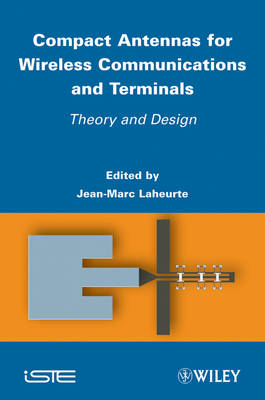
Compact Antennas for Wireless Communications and Terminals
ISTE Ltd and John Wiley & Sons Inc (Verlag)
978-1-84821-307-4 (ISBN)
Compact Antennas for Wireless Communications and Terminals deals with compact microwave antennas and, more specifically, with the planar version of these antennas. Planar antennas are the most appropriate type of antenna in modern communication systems and more generally in all applications requiring miniaturization, integration and conformation such as in mobile phone handsets.
The book is suitable for students, engineers and scientists eager to understand the principles of planar and small antennas, their design and fabrication issues, and modern aspects such as UWB antennas, reconfigurable antennas and diversity issues.
Jean-Marc Laheurte is a professor at the Université Paris-Est Marne-La-Vallée in France.
Introduction xi
Chapter 1. General Information About Printed Antennas 1
Jean-Marc LAHEURTE
1.1. Physical characteristics 1
1.2. Properties, limitations, and applications 4
1.3. Printed rectangular antenna viewed as a wide microstrip line 7
1.4. Manufacturing processes 8
1.5. Microwave substrates 11
Chapter 2. Transmission Line Model 15
Jean-Marc LAHEURTE
2.1. Introduction15
2.2. Equivalent circuit 16
2.3. Input impedance 20
Chapter 3. Cavity Model 25
Jean-Marc LAHEURTE
3.1. Introduction 25
3.2. Formulation of the electromagnetic problem 25
3.3. Calculation of expressions for fields and currents of a rectangular patch 29
3.4. Expressions for principal modes 31
3.5. Cartography of modal currents and associated radiation patterns 33
Chapter 4. Radiation of a Printed Antenna 39
Jean-Marc LAHEURTE
4.1. Introduction 39
4.2. Modelization using two equivalent radiating slots 40
4.3. Calculation of the field radiated by a horizontal radiating slot 43
4.4. Calculation of the field radiated by the rectangular patch 44
4.5. Determination of the radiation pattern in the principal planes 44
4.6. Influence of height 46
4.7. Influence of the ground plane 47
4.8. Polarization 48
4.9. Directivity 49
4.10. Influence of the substrate on resonant frequency: parametric study based on antenna RCS 51
Chapter 5. Electrical Equivalent Circuit of a Printed Antenna 55
Jean-Marc LAHEURTE
5.1. Energy considerations 55
5.2. Equivalent circuit 57
5.3. Determination of WE, WM, and B for a rectangular patch 58
5.4. Modeling using a tank circuit 60
5.5. Quality factor of an antenna 62
5.6. Calculation of radiation quality factor 63
5.7. Calculation of efficiency 64
5.8. Influence of surface waves on bandwidth and efficiency 67
Chapter 6. Feeding Circuits for Microstrip Antennas 69
Jean-Marc LAHEURTE and Benoît POUSSOT
6.1. Introduction 69
6.2. Direct coupling by coaxial probe 71
6.3. Excitation by proximity coupling 73
6.4. Excitation by slot coupling 74
Chapter 7. Circularly Polarized Antennas 89
Jean-Marc LAHEURTE, Marjorie GRZESKOWIAK and Stéphane PROTAT
7.1. Principles of circular polarization 90
7.2. Parasitic radiation – degradation of circular polarization 94
7.3. Patch fed by single or dual excitation 96
7.4. Sequential array 99
7.5. Spiral and quadrifilar helix antennas 108
7.6. Conclusion 119
Chapter 8. Wideband Antennas 121
Xavier BEGAUD
8.1. Multiresonant antennas 122
8.2. Traveling wave antennas 125
8.3. Frequency independent antennas 126
8.4. Ultra-wideband antennas 132
8.5. Conclusion 140
Chapter 9. Miniature Antennas 143
Guillaume VILLEMAUD
9.1. Introduction 143
9.2. Which types of antennas should be used for integration? 144
9.3. Integration limits in a finite volume 145
9.4. Resonant antennas in fundamental mode 146
9.5. Bulk reduction techniques 152
9.6. Multiresonant antennas 164
9.7. Synthesis and discussion 166
Chapter 10. Reconfigurable Antennas 169
Jean-Marc LAHEURTE
10.1. Introduction 169
10.2. Basic topologies and constraints 170
10.3. Switched components: available technologies 174
10.4. Frequency reconfigurable antennas (FRAs) 180
10.5. Introduction to RAs in terms of polarization and radiation pattern 185
10.6. Polarized reconfigurable antennas (PRAs) 187
10.7. Radiation pattern reconfigurable antennas (RPRAs) 190
Chapter 11. Introduction to Antenna Diversity 205
Lionel RUDANT
11.1. Benefits of antenna diversity 205
11.2. Performance of multiantenna systems 214
11.3. Multiantenna systems 222
11.4. Conclusion and looking toward MIMO 228
Bibliography 233
List of Authors 241
Index 243
| Verlagsort | London |
|---|---|
| Sprache | englisch |
| Maße | 163 x 241 mm |
| Gewicht | 626 g |
| Themenwelt | Technik ► Elektrotechnik / Energietechnik |
| Technik ► Nachrichtentechnik | |
| ISBN-10 | 1-84821-307-7 / 1848213077 |
| ISBN-13 | 978-1-84821-307-4 / 9781848213074 |
| Zustand | Neuware |
| Haben Sie eine Frage zum Produkt? |
aus dem Bereich


